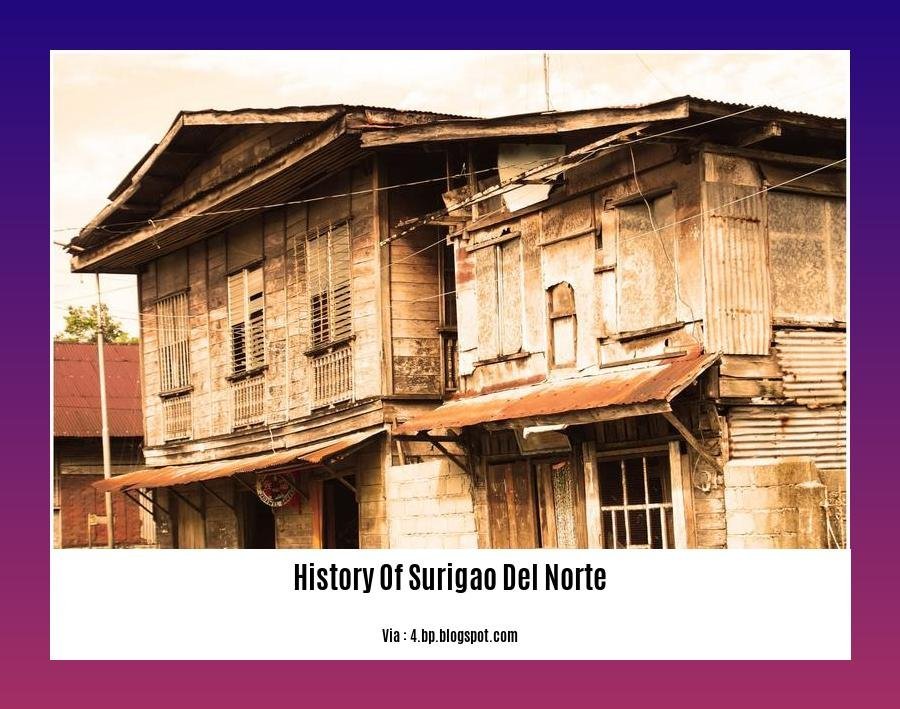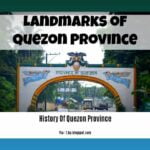Embark on a captivating journey through time as we uncover the rich tapestry of Surigao del Norte’s history. This enchanting province in the Philippines beckons with its captivating narratives of the past, waiting to be explored and unveiled. Prepare to be mesmerized as we delve into the depths of its cultural heritage, unraveling forgotten stories that have shaped its unique identity. Join us on this adventure as we embark on [A Journey Through Time: Uncovering the Rich History of Surigao del Norte].
Key Takeaways:
Surigao, a province in the Philippines, was initially part of the Caraga district during the early Spanish colonial period.
On May 15, 1901, under American administration, the Philippine Commission Act 127 established Surigao as a province.
Republic Act 2786, passed on September 18, 1960, divided the province into two: Surigao del Norte and Surigao del Sur.
The capital of Surigao del Norte, Surigao City, was granted chartered city status on August 31, 1970.
History of Surigao del Norte

The history of this province is comprehensive and traces the influence of various powers. Surigao’s exploration started with Ferdinand Magellan in 1521, who charted the port of Siargao. In the 16th century, the Spaniards colonized and developed the town of Surigao, naming it the capital of Caraga, a large district encompassing a vast expanse of land in Northeastern Mindanao.
Fast forward to the American period, Philippine Commission Act 127, enacted on May 15, 1901, marked a pivotal moment for Surigao. This act shattered the previous Caraga district into various provinces, including Surigao. Consequently, Surigao, Agusan, and Davao formed a single district.
In 1960, Republic Act 2786, approved on September 18, brought about the division of Surigao into two distinct provinces: Surigao del Norte and Surigao del Sur. This division was driven by administrative convenience, facilitating better governance and services for each province’s unique needs.
Surigao del Norte’s capital, the city of Surigao, reached another milestone on August 31, 1970, when it officially became a chartered city. This designation signified the city’s growth and development, recognizing its importance as a regional hub for commerce, trade, and industry. Today, Surigao del Norte stands as a province steadfastly rooted in its rich history, a tapestry woven with influences from diverse cultures throughout the centuries.
Find out more about the history of soccer in Mexico, a legacy that spans over a century and is brimming with captivating stories and moments of glory. history of soccer in mexico
To understand the roots and evolution of the Ethiopian Orthodox Church, delve into its intricate history, which dates back to the 4th century. history of the ethiopian orthodox church
World War II and the Japanese occupation: A tumultuous chapter in Surigao del Norte’s history
Surigao del Norte’s shores bore witness to the horrors of World War II when the Japanese occupation cast a dark shadow over the province. From 1942 to 1944, the Japanese military controlled this region, leaving an indelible mark on its people and landscape.
In October 1944, the Battle of Surigao Strait unfolded, a pivotal naval clash between American and Japanese forces. Fought in the waters just off Surigao del Norte’s coast, the battle was a crucial component of the larger Battle of Leyte Gulf. American battleships, cruisers, and destroyers faced off against their Japanese counterparts, including battleships, cruisers, destroyers, and aircraft carriers.
The battle raged for hours, with both sides unleashing their firepower. In the end, the Americans emerged victorious, sinking several Japanese ships, including the mighty battleship Yamashiro. This decisive victory marked the end of the Japanese naval threat in the Philippines and turned the tide of the war in the Pacific.
The Japanese occupation and the Battle of Surigao Strait left a profound impact on Surigao del Norte. The province endured hardships, loss, and destruction during those tumultuous years. Yet, the resilience and bravery of its people shone through, as they resisted the occupiers and fought for their freedom.
Today, Surigao del Norte stands as a testament to the indomitable spirit of its people. The province has risen from the ashes of war, rebuilding and flourishing into a vibrant and prosperous region. The memory of World War II and the Japanese occupation serves as a reminder of the sacrifices made by previous generations, ensuring that their legacy lives on for generations to come.
Key Takeaways:
- World War II and the Japanese occupation left a lasting impact on Surigao del Norte.
- The Battle of Surigao Strait was a decisive American victory that turned the tide of the war in the Pacific.
- The people of Surigao del Norte endured hardships, loss, and destruction during the war but demonstrated resilience and bravery in the face of adversity.
- The province has rebuilt and flourished since the war, standing as a testament to the indomitable spirit of its people.
Sources:
[1] The Battle of Surigao Strait – Philippine News Agency
[
[2] The Battle of Surigao Strait: The Last Battleship Duel – HistoryNet
[
Post-war era and the struggle for independence

Amidst the ruins and remnants of war, the people of Surigao del Norte embarked on a remarkable odyssey, striving to rebuild their lives and reclaim their freedom during the post-war era. The province faced immense challenges, including widespread devastation, economic turmoil, and the lingering presence of colonial influences. However, the indomitable spirit of the Surigaonons shone through as they united to confront these adversities and forge a path towards self-determination.
In the years that followed World War II, Surigao del Norte became a hotbed of resistance against lingering colonial forces and the struggle for independence gained momentum. Local leaders, armed with a deep sense of patriotism and a burning desire for freedom, mobilized the populace and organized resistance movements. The people of Surigao del Norte fought valiantly, employing guerrilla tactics and demonstrating unwavering resilience in their pursuit of independence.
The post-war era in Surigao del Norte was marked by both triumphs and setbacks. The province witnessed the establishment of local governments and institutions, laying the foundation for self-governance. However, the struggle for independence was far from over as the region grappled with issues of poverty, social inequality, and political turmoil.
Despite these challenges, the people of Surigao del Norte remained steadfast in their pursuit of freedom. Their unwavering determination and resilience ultimately paved the way for the province to emerge as a symbol of independence and self-determination. The post-war era in Surigao del Norte stands as a testaments to the indomitable spirit of the Filipino people and their unwavering commitment to freedom and self-governance.
Key Takeaways:
Surigao del Norte faced significant challenges during the post-war era, including widespread devastation, economic turmoil, and the lingering presence of colonial influences.
The people of Surigao del Norte demonstrated unwavering resilience and unity in their pursuit of independence, organizing resistance movements and employing guerrilla tactics.
The post-war era in Surigao del Norte was marked by both triumphs and setbacks, with the establishment of local governments and institutions, but also ongoing struggles with poverty, inequality, and political turmoil.
Despite the challenges, the people of Surigao del Norte remained steadfast in their pursuit of freedom, eventually emerging as a symbol of independence and self-determination.
Sources:
- The Philippines: A Country Study
- Surigao del Norte: History and Culture
Recent developments and the emergence of Surigao del Norte as a tourism destination
In the heart of the Caraga region, nestled between the glistening waters of the Philippine Sea and the verdant slopes of the mountain ranges, lies the enchanting province of Surigao del Norte. This captivating destination has quietly emerged as a tourism hotspot, drawing adventurers and nature enthusiasts alike with its pristine beaches, majestic waterfalls, and captivating historical and cultural treasures.
Surigao del Norte’s transformation into a tourism haven is a testament to the province’s commitment to sustainable development, preserving its natural beauty while promoting responsible tourism practices. This delicate balance has allowed the province to showcase its stunning landscapes, rich biodiversity, and vibrant culture without compromising the integrity of its environment.
The province’s recent developments have played a pivotal role in its burgeoning tourism industry. The construction of world-class infrastructure, including modern airports, improved road networks, and state-of-the-art resorts, has made Surigao del Norte more accessible and enticing to both domestic and international travelers.
Key Developments Driving Tourism Growth:
Siargao Island’s Allure: Siargao Island, renowned for its world-class surfing spots and breathtaking beaches, has been a major catalyst for Surigao del Norte’s tourism boom. In recent years, the island has gained international recognition, attracting surfers from around the globe who seek the perfect wave.
Ecotourism Initiatives: Surigao del Norte has embraced ecotourism as a sustainable approach to tourism development. The province has established several protected areas, including the Sohoton Natural Bridge National Park, where visitors can marvel at the majestic natural bridge and explore the diverse flora and fauna of the region.
Cultural Heritage Preservation: Recognizing the importance of preserving its rich cultural heritage, Surigao del Norte has undertaken various initiatives to promote and protect its indigenous traditions, arts, and crafts. The province regularly hosts cultural festivals and events, providing visitors with an immersive experience of the local way of life.
Surigao del Norte’s emergence as a tourism destination is a testament to its commitment to responsible development, showcasing its natural wonders and cultural heritage while ensuring the well-being of both its people and the environment.
Key Takeaways:
Surigao del Norte’s stunning natural beauty, including its pristine beaches, majestic waterfalls, and diverse flora and fauna, attracts nature enthusiasts and adventure seekers.
The province’s commitment to sustainable development and responsible tourism practices ensures that its natural and cultural heritage are preserved for future generations.
Recent developments, such as improved infrastructure, ecotourism initiatives, and cultural heritage preservation, have contributed to Surigao del Norte’s emergence as a leading tourism destination.
Siargao Island, with its world-class surfing spots and breathtaking beaches, has played a significant role in boosting Surigao del Norte’s tourism industry.
The province’s rich cultural heritage, showcased through festivals and events, offers visitors an immersive experience of the local way of life.
Sources:
[1] Surigao del Norte: A Journey Through Time:
[2] Surigao del Norte Tourism: A Guide to the Natural Wonders and Cultural Heritage:
FAQ
Q1: What significant historical event took place in Surigao del Norte during World War II?
A1: During World War II, the Battle of Surigao Strait occurred on October 25, 1944, marking the last significant naval battle. This clash involved American and Japanese naval forces and resulted in an American victory.
Q2: When did Surigao del Norte become a separate province?
A2: Surigao del Norte emerged as a distinct province on September 18, 1960, through Republic Act 2786. This act divided the original Surigao province into Surigao del Norte and Surigao del Sur.
Q3: Which municipality in Surigao del Norte serves as its capital?
A3: Surigao City, a chartered city, holds the distinction of being the capital of Surigao del Norte. It obtained its city status on August 31, 1970.
Q4: What are some popular tourist destinations in Surigao del Norte?
A4: Surigao del Norte boasts beautiful islands that attract tourists. Siargao and Bucas Grande are renowned for surfing and other outdoor activities, making them popular destinations.
Q5: How many municipalities and component cities make up Surigao del Norte?
A5: Surigao del Norte comprises 20 municipalities and 1 component city. This distribution contributes to the province’s rich cultural and geographic diversity.












